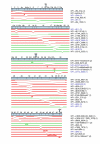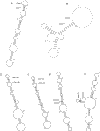Complex splicing pattern generates great diversity in human NF1 transcripts
- PMID: 12057013
- PMCID: PMC115845
- DOI: 10.1186/1471-2164-3-13
Complex splicing pattern generates great diversity in human NF1 transcripts
Abstract
Background: Mutation analysis of the neurofibromatosis type 1 (NF1) gene has shown that about 30% of NF1 patients carry a splice mutation resulting in the production of one or several shortened transcripts. Some of these transcripts were also found in fresh lymphocytes of healthy individuals, albeit typically at a very low level. Starting from this initial observation, we were interested to gain further insight into the complex nature of NF1 mRNA processing.
Results: We have used a RT-PCR plasmid library based method to identify novel NF1 splice variants. Several transcripts were observed with specific insertions/deletions and a survey was made. This large group of variants detected in one single gene allows to perform a comparative analysis of the factors involved in splice regulation. Exons that are prone to skipping were systematically analysed for 5' and 3' splice site strength, branch point strength and secondary structure.
Conclusion: Our study revealed a complex splicing pattern, generating a great diversity in NF1 transcripts. We found that, on average, exons that are spliced out in part of the mRNA have significantly weaker acceptor sites. Some variants identified in this study could have distinct roles and might expand our knowledge of neurofibromin.
Figures



References
-
- Staley JP, Guthrie C. Mechanical devices of the spliceosome: motors, clocks, springs, and things. Cell. 1998;92:315–326. - PubMed
LinkOut - more resources
Full Text Sources
Other Literature Sources
Research Materials
Miscellaneous

